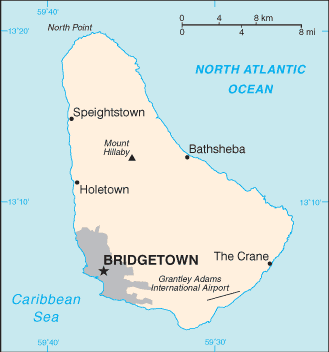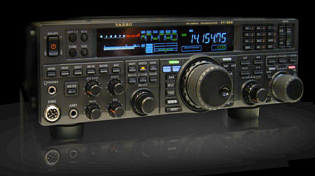
Ahhhhhh, warm, sunny, clear blue waters outside the door of a rented villa. Monday January 26th saw me leaving Ottawa (-29C) for a short holiday in beautiful friendly Barbados (28C). Ron, 8P6JB did all the paperwork and running around getting my license to operate in Barbados. I settled on the call 8P9VE as this represented a little of Canada in it.
The villa was at Reeds House on the north west shore of Barbados. The back entrance and patio of the villa descended to a white sand beach and palm trees. Very much a heaven compared to icy frozen Canada. I traveled with my VX-170 and VX-3R handhelds and a small external window mounted antenna. I just happened to be in the shadow of the island repeaters so I couldn't qso with anyone from the villa unless I was in the rented van and up at a high point away from shore.

The Barbados Amateur Radio Society meets at their club station every Friday night for a social get together, and Ron 8P6JB invited me to attend. The club station is located at one of the highest points of land on the island just outside Bridgetown. It sits on a former sugar plantation and you can see the remnants of the old wind mill that powered the plantation machinery.

The Friday meetings are very informal and softdrinks and beer are available to all - which probably makes these meeting very popular. I got to operate the club station which is equipped with very modern up to date gear.

Peter, 8P9NX, a retired M.D. from the Mayo clinic in Minnesota was operating the station when I arrived. He quickly set up the club laptop for psk and I made a few stateside contacts on 40m psk that evening.

Peter's obsession is golf and ham radio since he retired to the island a few years ago. He plans to sail his 37 foot sailboat with his son, from the U.S. to Barbados later this year. Peter works about 50 stations a day on his K3 and CW - he does a bit of psk too.
Barbados currently has about 150 licensed ham radio operators. Barbados' population is 281,968 (July 2008 Est.). Peter was telling me that at these latitudes 80 meters and 160 meters are great in the evenings with very low noise levels. Getting a license to operate in Barbados cost $15USD and you have to send a copy of your Canadian license and a list of all the equipment you'll be bringing to the island. The license is good for one year and I plan to go back in a few months with my own equipment and a couple of my PAR EndFed antennas packed away in my suitcase. Using the 8P9 call created quite a stir on 40 meters but qrm was high due to the number of stations.

The club station also has emergency backup power via batteries and generators in case of natural or man made disasters. The stations included a Yaesu FT-1000 MkV, an FT-450, 2 meter handhelds and base radios along with older Kenwood and Icom radios - so a very well designed and equipped ham station. Antennas include wire dipoles, various beams and verticals.
I would like to thank again Ron Wilkinson 8P6JB for all of the legwork and keeping in contact with me while on Barbados and the great Friday evening club meeting of January 30, 2009. And a big thanks to Peter 8P9NX for showing me the ropes at the club station.
Geography Area: 431 sq. km. (166 sq. mi.); 2.5 times the size of Washington, DC.
Cities:
Capital--Bridgetown.
Terrain: Generally flat, hilly in the interior.
Climate: Tropical.

 I've been busy spring cleaning and finally found my ham license issued to me in the spring of 1990 while I was stationed in Slovakia. My call at that time was OK8AIO and I got to use it a few times from the Technical University of Kosice ham station. A few of the student hams helped me obtain a license to operate there. The photos are from Wenceslaus Square in Prague, during the final days leading to the election.
I did manage to make a few contacts back to Ottawa with a list of ham gear to be sent to me. A packet tnc and an all mode 2 meter transceiver, a Kenwood TR-9000 and a 5/8 mag mount whip antenna and 100 feet of coax. I had a floppy disk based Tandy (Radio Shack) black and white laptop and some terminal software and was able to connect to a node in Budapest Hungary.
I've been busy spring cleaning and finally found my ham license issued to me in the spring of 1990 while I was stationed in Slovakia. My call at that time was OK8AIO and I got to use it a few times from the Technical University of Kosice ham station. A few of the student hams helped me obtain a license to operate there. The photos are from Wenceslaus Square in Prague, during the final days leading to the election.
I did manage to make a few contacts back to Ottawa with a list of ham gear to be sent to me. A packet tnc and an all mode 2 meter transceiver, a Kenwood TR-9000 and a 5/8 mag mount whip antenna and 100 feet of coax. I had a floppy disk based Tandy (Radio Shack) black and white laptop and some terminal software and was able to connect to a node in Budapest Hungary.  It's hard to believe all of this happened 19 years ago now.
It's hard to believe all of this happened 19 years ago now.
 My antenna farm survived the brutal, windy, snowy, freezing rain type weather known in this neck of the woods. Some good planning, engineering and blind luck allowed my PAR EndFedz and my Cushcraft R6000 to survive unscathed through the arctic like conditions up here. A 3-point guy system protected my R6000 from self-destruction. The PAR EndFedz were securely anchored with enough slack to survive the windy conditions south of Ottawa. We do get some extreme winds out here. A couple of years ago, during a micro-burst type summer storm I lost some siding on the upper story of my home. Anything not anchored down gets blown to the next county.
My antenna farm survived the brutal, windy, snowy, freezing rain type weather known in this neck of the woods. Some good planning, engineering and blind luck allowed my PAR EndFedz and my Cushcraft R6000 to survive unscathed through the arctic like conditions up here. A 3-point guy system protected my R6000 from self-destruction. The PAR EndFedz were securely anchored with enough slack to survive the windy conditions south of Ottawa. We do get some extreme winds out here. A couple of years ago, during a micro-burst type summer storm I lost some siding on the upper story of my home. Anything not anchored down gets blown to the next county.









 Peter's obsession is golf and ham radio since he retired to the island a few years ago. He plans to sail his 37 foot sailboat with his son, from the U.S. to Barbados later this year. Peter works about 50 stations a day on his K3 and CW - he does a bit of psk too.
Peter's obsession is golf and ham radio since he retired to the island a few years ago. He plans to sail his 37 foot sailboat with his son, from the U.S. to Barbados later this year. Peter works about 50 stations a day on his K3 and CW - he does a bit of psk too.

